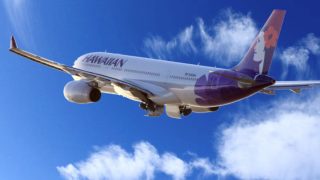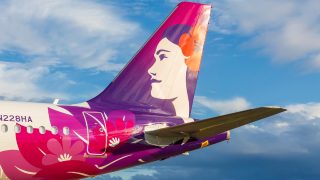A new chapter in Hawaii’s aviation landscape began today with Alaska Airlines’ acquisition of Hawaiian Airlines, bringing a complex blend of hope and uncertainty. This merger, the first significant U.S. airline deal since Alaska purchased Virgin America in 2016, gives Alaska access to more airports, planes, and routes.
CEO Ben Minicucci has already outlined his vision of Alaska becoming a wide-body operator, leveraging Hawaiian’s fleet to support Alaska’s international expansion goals.
However, as Alaska looks to the future with growth plans, many questions linger about what this will mean for Hawaii. Potential shifts in routes, fleet management, and even the relocation of personnel and aircraft leave residents, employees, and frequent visitors wondering how these changes will affect the islands and their global connectivity.
What do Pualani and the Eskimo represent to Hawaii and Alaska?
Before the deal’s completion, widespread concerns existed about a possible culture clash between the two airlines. Steeped in its century-old spirit of Aloha, Hawaiian Airlines has long represented more than just an airline—it symbolizes local pride and a connection to Hawaii’s people and culture.
Since 1973, when Pualani first appeared on the tail of Hawaiian Airlines’ jets, she has symbolized more than just an airline—she embodies the spirit of Hawaii everywhere she flies. Pualani, meaning “heavenly flower,” represents the Hawaiian Islands’ grace, beauty, and culture. For locals, seeing Pualani at airports worldwide evokes pride and a connection to home. Like its iconic symbol, Hawaiian Airlines has long represented a link to the islands’ culture and identity.
Similarly, the Eskimo on Alaska Airlines’ tail has symbolized the airline’s connection to Alaska and its indigenous people since 1972. While the exact identity of the face remains a mystery, the Eskimo was chosen to represent the Arctic region and its people. For Alaskans, the logo serves as a reminder of the region’s resilience and deep cultural roots, particularly for those in remote areas who rely on Alaska Airlines for essential travel and goods.
The merger brings hope that both companies can find harmony while preserving what makes each brand unique. However, for many in Hawaii, the fear remains that Hawaiian Airlines could lose its distinct identity under Alaska’s corporate umbrella.
Alaska Airlines has an opportunity here to celebrate both Hawaiian and Alaskan cultures, leveraging the rich identities each brand has cultivated. If done well, the merger could create a powerful symbol of unity between these two unique regions. Watching the two airlines navigate their shared future will be a fascinating journey.
This concern was also articulated by JimT, a local who commented:
“Please, Alaska, don’t f*** up this important part of Hawaiian culture. One of the nation’s oldest, and it means a great deal to the people of the state.”
Widebody planes: Will Hawaii lose any of its long-haul hub?
One of the most pressing questions following the acquisition concerns Hawaiian Airlines’ widebody Airbus A330 planes, which have been critical for the airline’s long-haul international routes. Alaska Airlines, which has primarily flown Boeing 737 narrow-body jets, now has access to these larger widebody aircraft. Still, there’s already talk of moving some of them to Seattle to boost Alaska’s international footprint from its primary hub.
In an interview with The New York Times, CEO Ben Minicucci confirmed his ambition to make Alaska a wide-body operator, with plans to base some of Hawaiian’s A330 planes in Seattle.
“We saw the potential of us becoming a wide-body operator, being able to offer international flights, potentially in the future out of Seattle—there was so much to like,” Minicucci said.
For Hawaii, this raises concerns that Honolulu could lose its status as a major long-haul hub. Fewer international flights departing directly from the islands could have significant implications for tourism—Hawaii’s lifeblood—and could reduce the state’s current and future connectivity to key markets. Local travelers, too, may face fewer direct options, with more routes being redirected through Seattle, leading to longer and potentially more expensive journeys.
Flight attendants and employees: Relocation or job security?
For Hawaiian Airlines employees, particularly flight attendants and ground crew, the merger brings uncertainty about their future roles. Most Hawaiian Airlines crew members are based in Hawaii, enjoying a lifestyle strongly connected to the islands. However, with the possibility of some widebody planes being stationed out of Seattle, some employees may be faced with a tough decision: relocate or risk losing their positions.
Chris, a longtime Alaska Airlines flight attendant, expressed optimism about the merger but acknowledged that change is inevitable:
“The family atmosphere of AS is very evident. The ohana runs deep at AS, too. There will undoubtedly be changes, but the future is very bright for a now larger HA/AS family.”
While employees like Chris hope for a smooth transition, many remain concerned about the potential impact on their personal lives and job stability. Will Hawaiian Airlines’ very apparent ohana spirit survive the merger, or will corporate demands lead to a disconnection from the island culture?
Interisland travel: Will prices rise without competition?
A repeated concern for Hawaii residents is the potential impact on interisland travel. Hawaiian Airlines has long been the dominant carrier for these essential routes, but the arrival of Southwest Airlines a few years ago introduced more competition, helping to drive down fares. Many residents, like Gaga, fear that without enough competition, interisland prices could rise again:
“Hawaii residents really need Southwest in Hawaii. If they don’t have it, Hawaiian will go back to charging $150 for an interisland flight.”
If the merger leads to a shift in priorities, reduces competition further, or changes flight frequencies and aircraft types, residents could find themselves less satisfied and paying more for the short flights between islands—an essential service for both personal and business travel in Hawaii.
Financial implications: Stocks, integration, and what’s next.
In the financial world, Hawaiian Airlines’ stock has stopped trading, signaling the formal end of an independent Hawaiian Airlines. For investors, the next big question is whether Alaska Airlines can successfully integrate the two carriers without facing the financial and operational issues plaguing past airline mergers, including Alaska’s acquisition of Virgin America.
Alaska Airlines CEO Ben Minicucci, who led the company through the Virgin America acquisition, expressed confidence that this merger will go more smoothly, citing lessons learned from previous integrations:
“This is not our first rodeo,” Minicucci said. “Most of the folks are still here at Alaska that did that integration, so all those lessons learned are still vivid in our minds.”
Despite this confidence, many airline industry analysts have expressed caution about a range of potential risks. They note that Hawaiian Airlines is struggling with weak earnings and the broader economic uncertainty facing both Hawaii and mainland travel.
A future filled with both promises and questions.
The Alaska-Hawaiian merger opens the door to a new future for both airlines while leaving many questions unanswered. Hawaii’s air travel landscape is central to the state’s economy and lifestyle and is poised for significant changes. As Alaska Airlines moves forward with its vision, including international expansion and operational integration, Hawaii and its aficionados will watch closely, hoping that the unique culture and connections Hawaiian Airlines has built over decades are not lost in the complicated process.
And a final note about frequent flyer programs.
We are learning this afternoon that there will be an announcement forthcoming about both the transferring of miles between programs and the ultimate combination of the two programs. Look for that to follow soon, but you can expect to be able to at least transfer miles within weeks from what we were just told.
Hope and uncertainty reign as this new chapter begins. We welcome your input!
Get Breaking Hawaii Travel News







Whoa! Not true! The debut of Alaska’s Eskimo was in 1960, not 1972! It was 1960 when former CEO Charlie Willis acquired four 737-100s and commissioned four colorful line drawings to adorn the tail of the new planes: 1-a gold miner with his pick axe; 2-a stand of evergreen trees; 3-a onion-domed Orthodox Church; and, finally 4-an Eskimo. It was 10 years later – after acquisition of more 727s to Alaska’s then four-plane fleet – that the Eskimo became the choice for a uniform corporate image by appearing on the entire Alaska fleet.
Well, this makes our upcoming trip interesting. We’ll have Hawaiian to Maui & Alaska to San Diego. Humm. I’ve flown both before, years ago, but we’ll see what this venture has in store for us.
Alaska will transform HA into a money making enterprise. There will be push back simply because the status quo of losing money on service / fares that were unstainable are going to go away. Hawaii got thier wish….less flights and tourists. But that means less flights and higher fares for residents.
I am quite surprised there isnt a robust ferry system in Hawaii across the islands….so i would actually like to see DOT Hawaii look into getting this public transport ferry network going instead of depending on airplanes (and its more eco-friendly too!).
For some time I thought that Hawaiian Air might replace the B-717 with the Airbus A-220, since they had been moving away from Boeing. Then, to my surprise they announced they were ordering the 787s! Maybe a move back to Boeing or just having both makers in the stable? Alaska has been all Boeing and unloaded the Virgin A-330s. It will be interesting to see what happens for our inter-island flights. I think the 717, as operated for inter-island is perfect, but, like me, they are getting old!
No wonder the Alaska Eskimo is smiling. He gets to meet up with the Hawaiian hula girl.
As an Alaska Airlines passenger since 1960 (and an Hawaiian Airlines passenger since 1970), I see some comments here that have lost perspective: This merger is far from the “first rodeo” for either airline: Under former Alaska President Charlie Willis in 1960, the airline was known around the state as “Elastic Airlines” for its chronically tardy flights. Enter President/VicePresident Ron Cosgrave and Bruce Kennedy’s reorganization, Alaska became the quality airline it is today.
Another great example of the two carriers shared legacies. In the 90’s HAL was known as “Hawaiian Always Late” . Both airlines survived the ultra competitive deregulation era that eliminated so many larger carriers and against long odds. They were underdogs who prevailed thanks in large part to the employees and leaders like Alaska’s Kennedy and HA’S Dunkerley . Both airlines have a long history of community involvement and respect for their communities.
I understand residents of Hawaii concerned about intra island fares, but the fact is HA was going bankrupt, Aloha Air also bankrupt . You gotta make $ I hope Alaska figures it out
I am delighted that AS took over the company. Not that I did not like HA, much the contrary. Always had a great experience with HA. I am happy that SWA did not try to take over! After my 4 very bad experiences with SWA, I would not fly them across the street, much less intra island or trans-pacific! AS offers a much better service experience! The handwriting is on the wall for SWA & their service in the Hawaiian Islands! SWA is going down next!
Thank you for quoting me in the article, however I am not a local. My son’s family are residents in Napili and we visit often now for several years and perhaps my frequent posts gave the impression I am a resident.
I will want to emphasize that after flying other airlines over the years, in 2018 we “standardized” on Hawaiian as they onboard product was much better. Actually, it is the service of everyone from those who help travelers at the check-in kiosks to the time we get off the plane.
My only beef with Hawaiian is the lousy app and offshore customer service.
The irony in all this is that after managing a completely botched transition from SABRE to AMADEUS, Hawaiian will very likely transition back to SABRE. Hopefully, this time with full functionality.
Recently learned that Horizon Air, Alaska’s subsidiary airline flies the 78 passenger Embraer E-175 twin jet to secondary markets. I wonder if Alaska will replace Hawaiian’s B717s with the much smaller E-175? I believe Mokulele flew these planes for a very short time about 10 years ago.
And yes, I am worried about inter-island plane fares should Southwest abandon that market. We need competition on these routes to keep fares fair. Hawaiian had a bad reputation of spiking up inter-island fares when competition disappeared.
Eskimo? I always thought that was Johnny Cash on the tail.
These concerns and questions are natural and entirely expected. Alaska management is keenly aware of the importance of the Hawaiian Airlines brand and cultural heritage. The Alaska Airlines brand has a similar heritage in the state of Alaska. Both airlines have been around for over 90 years. The very last thing Alaska management wants to do is f*** this up. Relatively short-lived Virgin America had nowhere near the importance of the Hawaiian Airlines brand.
“Base some A330s in Seattle.” Sounds like Virgin America 2.0. Alaska is just Hawaiian for the planes and crews and they’re gonna gut the rest of the airline. A sad day for Hawaiian aviation.
I dont think its exactly Virgin 2.0 (they at least committed to keeping the brand, where it was clear VX would disappear).
You are going to see the aircraft right sized for the demand. I wouldnt even be surprised to see a HNL to LHR on HA 789 in the near future.
Flying to SYD or AKL from HNL may not make much sense but perhaps be now profitable with connections from AS. The numbers will be crunched and the best use of the aircraft will be implemented.
You may see a lot more OW connections now in HNL…..so its not all bad.
Southwest is about to gut Hawaii simply because you cant keep losing money forever.
Alaska acquired Hawaiian purely as an investment to boost its bottom line. Alaska has already “sliced and diced” and analyzed the data. So, sadly for Hawaii residents, major changes are inevitable!
Shaved ice might just become snow cones.
Shave ice, not shaved ice… lol
Aloha M
Sorry for the technicality but in the state I live in we all get the dreaded plain snow cones without any tropical flavors.
Ben Minicucci really better not screw this up, he pissed off a lot of mainlanders when he absolutely ruined Virgin America. People bought that ticket for the experience, but he was so arrogant he just ruined it, and lost premium travelers.
I respectfully disagree. Alaska Airlines did not “ruin” Virgin America, as it had an unsustainable business model. I admit, Alaska didn’t perfectly execute the merger, but lesson learned. (I would proffer that other airlines did Much worse in their acquisitions — e.g., United buying Continental). Alaska Airlines is Very well run. Hawaiian Airlines has been a train wreck, with decades of poor management albeit with a great customer interface… NO aspersions to the flight crews over the years. Hawaiian was headed to bankruptcy without a merger…. That was pretty clear. (On a totally side note, Hawaiian ground staff has been absolutely Horrible for traveling pets — our neighbor has been hassled for a Tiny 8lb dog being “too big” interisland Oahu to Maui — Alaska has always been extremely reasonable — our 13lb dog has always been welcomed in-cabin). Hawaiian can be arbitrary and inconsistent at times.
Agree with your take on VA but “Decades of poor management”?? I would suggest the Dunkerly era was Hawaiian’s golden era if you will. Hawaiian became quite profitable and accumulated about 1 billion in cash and low debt. Covid is what caused their bleak situation with multiple reasons beyond their control that bleed their billion dollar cash reserve. I’m guessing the biggest cash drain was Japan going from their most lucrative routes to their biggest loser. The weak yen has hampered the return to profitability there. HA has ridden through the worst of it and Alaska will be the beneficiary of that market returning…….if they keep the Hawaiian brand intact. Agree about Alaska’s excellent pet policies, had a great experience with them!..and yes Hawaiian can be arbitrary and inconsistent, well put, …….the operation will benefit from Alaska’s expertise in sharpening that up….. I hope.
As a Flight Attendant with AS with over 30 years of flying I had first hand experience with the VX purchase. It was a business deal plan and simple. AS bought VX simply to block JetBlue from expanding it’s west coast presence. There were definitely some big bumps with our acquisition of VX and Many hard feelings amongst the VX team members. Lessons learned! VX was on the road to bankruptcy. VX was a flashy quirky airline, young, hip, party in the sky type experience. It had its place, but losing money on a monthly basis was not sustainable. VX had NO history like what AS and HA have. Both have a loyal customer base and commitment to each of our 90 year heritages. I have total confidence in my leadership to run HA, AS, and our sister airline Horizon successfully into a long future. I am looking forward to our 100th anniversary! This is going to be an exciting and positive journey!
As some one who was a VX FF, you are spot on.
VX was just not making money executing properly. I have been very happy with the migration to AS. They took the VX meals and made AS “more hip” brandwise. I think thier branding is fantastic.
Sure…they missed a few opportunities with VX (i.e. transcon premium market that i am sure they want )….
But HA is an absolute train wreck. This will provide some accountability to how they are run. Hawaii may not like it cuz it gets rid of the gravy train they have today that will go away
Just curious what is an FF? I understand VX, FA, FO but FF escapes me!
Virgin America was awesome! I’m thankful I got to fly them once before Alaska ruined them.
ex-VX FF here. In fact, very happy with the transition.
Sure….VX and the red is gone…but we got OW and a broader network. They made the VX elevate members right (albeit only a month ago to post the lifetime miles).
HA should be excited for the opportunities coming. Some may lose thier preferred 29 dollar fare….but it will be put on a path where it will be there into the future and not be a basketcase of unreliability that it has been.
AS is extremely well run…..in fact the reliability has been incredible considering the operational challenges of being in Alaska…..in fact i criticize too much for a 45 min delay because i never experience delays for 90% of my travels on AS!